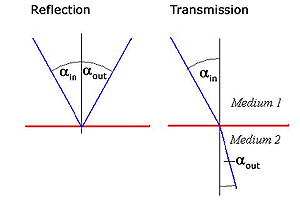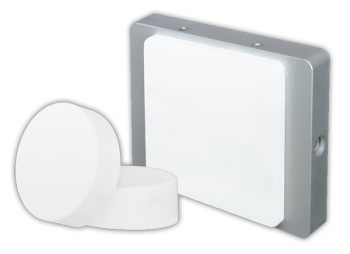II.8. Reflection, Transmission, and Absorption
Reflection is the process by which electromagnetic radiation is returned either at the boundary between two media (surface reflection) or at the interior of a medium (volume reflection), whereas transmission is the passage of electromagnetic radiation through a medium. Both processes can be accompanied by diffusion (also called scattering), which is the process of deflecting a unidirectional beam into many directions. In this case, we speak about diffuse reflection and diffuse transmission (Fig. II.14). When no diffusion occurs, reflection or transmission of an unidirectional beam results in an unidirectional beam according to the laws of geometrical optics (Fig. II.15). In this case, we speak about regular reflection (or specular reflection) and regular transmission (or direct transmission). Reflection, transmission and scattering leave the frequency of the radiation unchanged. Exception: The Doppler effect causes a change in frequency when the reflecting material or surface is in motion.
Absorption is the transformation of radiant power to another type of energy, usually heat, by interaction with matter.

Fig. II.14 - a-c: Direct, mixed and diffuse reflection d-f: direct, mixed and diffuse transmission

Fig. II.15 - When directly reflected or directly transmitted, an unidirectional beam follows the laws of geometrical optics: direct reflection (left): ain = aout, direct transmission (right): n1 · sin(ain) = n2 · sin(aout) with n1 and n2 denoting the respective medium's index of refraction
II.8.a. Reflectance r, Transmittance t, and Absorptance a
In general, reflection, transmission and absorption depend on the wavelength of the affected radiation. Thus, these three processes can either be quantified for monochromatic radiation (in this case, the adjective "spectral" is added to the respective quantity) or for a certain kind of polychromatic radiation. For the latter, the spectral distribution of the incident radiation has to be specified. In addition, reflectance, transmittance and absorptance might also depend on polarization and geometric distribution of the incident radiation, which therefore also have to be specified.The reflectance r is defined by the ratio of reflected radiant power to incident radiant power. For a certain area element dA of the reflecting surface, the (differential) incident radiant power is given by the surface's irradiance Ee, multiplied with the size of the surface element, thus
dFe,incident = Ee dA
and the (differential) reflected radiant power is given by the exitance Me, multiplied with the size of the surface element:
dFe,reflected = Me dA
Thus,

or
Me = r Ee
Total reflectance is further subdivided in regular reflectance rr and diffuse reflectance rd, which are given by the ratios of regularly (or specularly) reflected radiant power and diffusely reflected radiant power to incident radiant power. From this definition, it is obvious that
r = rr + rd
The transmittance t of a medium is defined by the ratio of transmitted radiant power to incident radiant power. Total transmittance is further subdivided in regular transmittance tr and diffuse transmittance td, which are given by the ratios of regularly (or directly) transmitted radiant power and diffusely transmitted radiant power to incident radiant power.
Again,
t = tr + td
The absorptance a of a medium is defined by the ratio of absorbed radiant power to incident radiant power.
Being defined as ratios of radiant power values, reflectance, transmittance and absorptance are dimensionless.
Quantities such as reflectance and transmittance are used to describe the optical properties of materials. The quantities can apply to either complex radiation or to monochromatic radiation.
The optical properties of materials are not a constant since they are dependent on many parameters such as:
• thickness of the sample
• surface conditions
• angle of incidence
• temperature
• the spectral composition of the radiation (CIE standard illuminants A, B, C, D65 and other illuminants D)
• polarization effects
The measurement of optical properties of materials using integrating spheres is described in DIN 5036-3 and CIE 130-1998.
Descriptions of the principle measurements are presented in paragraph III.1.f below.
II.8.b. Radiance coefficient qe, Bidirectional reflectance distribution function (BRDF)
The radiance coefficient qe characterizes the directional distribution of diffusely reflected radiation. In detail, the radiance coefficient depends on the direction of the reflected beam and is defined by the ratio of the radiance reflected in this direction to the total incident irradiance. In general, the reflected radiance is not independent from the directional distribution of the incident radiation, which thus has to be specified.
In the USA, the concept of Bidirectional reflectance distribution function BRDF is similar to the radiance coefficient. The only difference is that the BRDF is a function of the directions of the incident and the reflected beam (Fig. ). In detail, the (differential) irradiance dEe impinging from a certain direction causes the reflected radiance dLe in another direction, which is given by
dLe = BRDF · dEe
This BRDF depends on more arguments than the radiance coefficient. However, its advantage is the simultaneous description of the material's reflection properties for all possible directional distributions of incident radiation, whereas the radiance coefficient generally is valid for just one specific directional distribution of incident radiation.
The unit of radiance coefficient and BRDF is 1/steradian. The BRDF is often abbreviated by the Greek letter ρ, which bears the danger of mixing the BRDF up with reflectance (see foregoing paragraph).

Fig. II.16 - Geometry used for the definition of the bidirectional reflectance distribution function (BRDF). The BRDF depends on the directions of incident and reflected radiation, which are given by the angles Ji and Jr, which are measured relative to the reflecting surface's normal, and the azimuth angles ji and jr, which are measured in the plane of the reflecting surface.
Technical Sales Engineer
Full Time, Amesbury, MA, USA
Gigahertz-Optik Inc. is looking for a Technical Sales/Application Engineer for our innovative measurement instrumentation products.
Contact info-us@gigahertz-optik.com for details.
Practical Solutions to Real Light Measurement Problems
Here's The Problem:
You must design optical diffuser reflectors for a custom design LED sources that optimize and diffuse emitted light for specific tasks. The metal reflectors you have tried do not provide a diffuse light output. The various white coatings and paints diffuse the light sufficiently but are too fragile in some applications. Plus some of the coatings were not reflective enough, causing too low a light level.
There are other synthetic white reflectance materials that would work. However, the manufacturers do not sell just the material; they want to do the machining of the parts themselves.
Here's The Requirements:
- A durable high reflectance white optical diffuser material available as raw stock in various shapes and sizes for in-house machining.
- Fabrication of the parts in-house is necessary not only to save costs but to also allow the flexibility for trial and error design of multiple reflector solutions.
Here's The Solution:
ODM98 optical diffuser with high reflectance in various size unmachined plate, block, cylinder or film form.

Interested in discussing your light measurement application?
Give us a call!


